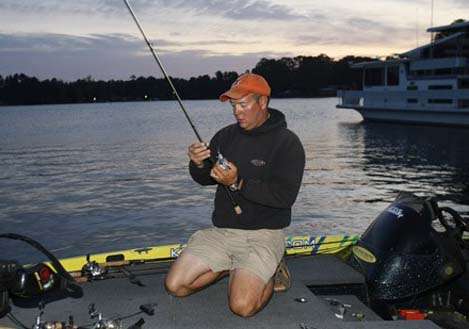
Before the Toyota Toyota Trucks All-Star Week voting started, Steve Kennedy was asked who he would like to see the fans vote into the tournament. The first name he mentioned was Aaron Martens.
“I think Aaron Martens could teach us something about how to catch those Coosa River bass,” Kennedy said. “I learn more from Aaron Martens than anyone on the tour.”
That statement exemplifies how much emphasis Kennedy places on continuing education in the world of bass fishing. To some, it might seem self-destructive to want another angler with more knowledge than you in the event. But Kennedy takes the long view. Anything he learns from Martens during All-Star Week might pay off in another tournament somewhere down the road.
As the son of a former Bassmaster Classic competitor – Van Kennedy – Steve Kennedy got more home schooling than most anglers. So the tips that some might have learned in a bass fishing seminar were most often old hat to the Auburn, Ala., angler.
“I’ve been to one seminar in my life where I actually learned something that really, really impressed me,” Kennedy said. “David Fritts came down to Georgia one time and gave a seminar. And it wasn’t like your typical seminar. We went into a classroom setting, and he sat down with everyone and said, ‘What do you want to know?’
“Someone asked him what his favorite color crankbait was, and he said, ‘Chartreuse with a brown back.’ He had won a couple of those Red Man regionals on Lake Sinclair.
“So I went out and custom-painted some crankbaits.”
So how did they work?
Kennedy looks you in the eyes, then looks away while adjusting the Auburn Tigers cap that usually sits atop his head. It’s a sign that Kennedy would just as soon not answer that question. But he eventually does.
“It’s pretty amazing,” Kennedy said. “That’s basically why I’m sitting here today, that one thing I got out of Fritts.”
And that, bass anglers, is a bold statement. Kennedy has won over $1 million on the B.A.S.S. circuit and another $650,000 in FLW events. His B.A.S.S. record includes two first-place finishes, two seconds, five thirds and 20 top 10s. Kennedy finished fifth in the Bassmaster Elite Series Toyota Tundra Angler of the Year race this season.
Kennedy had another important influence in his youth, this one far more unlikely than his bass fishing father.
“My grandmother was a pretty good painter,” Kennedy said. “She made me take all those art classes growing up as a kid. I won’t say I hated it, but Grandma made me do it, Mom made me do it, it was one of those things.”
After Kennedy heard Fritts’ comment about crankbait colors in 1996, he put those childhood art lessons in practice, bought an airbrush painting kit and began custom painting lures.
“It’s pretty neat to have a creative outlet at this point,” said Kennedy, who has a mechanical engineering degree from Auburn. “As an engineer, being creative is a big part of it.
“There are very few baits that I fish stock – very, very, very few. I carry an airbrush with paints, and I’ve had some real good tournaments because of it.”
The 2008 Bassmaster Elite Series schedule provides a good example. There were back-to-back tournaments in May on lakes where blueback herring are the dominant bass forage. Kenyon Hill won the first one at Clarks Hill in Georgia, where the Sebile Magic Swimmer swimbait emerged as a good blueback herring imitation.
Because of that name, blueback herring lures often have a blue tint on the back. But the baitfish actually has a green-gray tint, not blue. So Kennedy went swimbait shopping after the Clarks Hill tournament, came to South Carolina’s Lake Murray two weeks later and got out the airbrush kit.
“I custom painted those Sebiles after I saw what color the bait was,” Kennedy said. “I didn’t even know about that swimbait until Kenyon won over at Clarks Hill. I got a few to practice with at Murray, and in a matter of three or four days I had them custom painted and almost won.”
Kennedy finished second to Fred Roumbanis at Murray and earned a check for $42,000.
Kennedy looks at every lure with the eye of an artist, not just the hard bodies, like crankbaits and some swimbaits.
“Most of the time when you’re fishing a frog, you aren’t imitating a frog,” Kennedy said. “You’re imitating a bluegill.”
That white belly on most soft plastic frogs gives Kennedy a clean slate to apply his art skills.
“Frogs dye very well with an airbrush,” Kennedy laughed.
That’s just one final example of how Kennedy spots a bass fishing trend, thinks about it, then allows his creativity to go to work.




